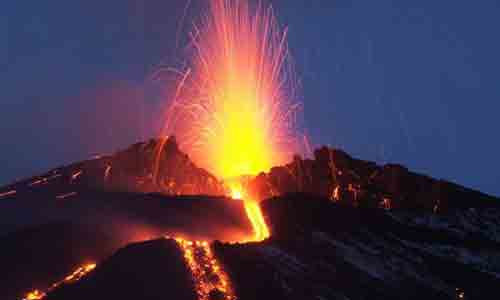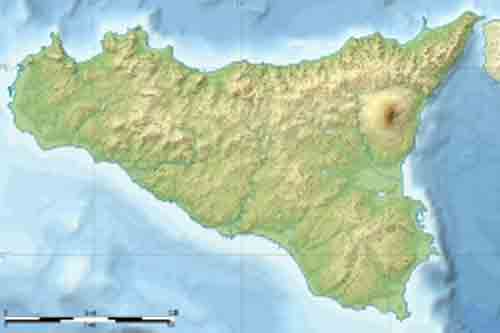Volcanic Lapilli sample Raw Minerals Ash Lava Bombs Stones Rocks for Collection.
Specimen of Volcanic Ember Pumice erupted from Mount Etna Volcan during the eruption of 7 March 2021.
The collection consists of small tephra, bits of pulverized rock and glass created by volcanic eruptions, in diameter between 3 and 7 mm.
The lapilli sample (about 8-9.5 gr) is labelled and bagged in a vial with cap (mm 50 x 25), so thay can easily be removed if required for study under a microscope.
Etna (or Mongibello) is a volcano on the east coast of Sicily that originated in the Quaternary: it is the highest terrestrial active volcano of the Eurasian plate. Its frequent eruptions over time have changed, sometimes even profoundly, the surrounding landscape and on many occasions have constituted a threat to the settlements born on its slopes.
With a diameter of over 40 kilometers and a base perimeter of approximately 135 km, it occupies an area of 1265 km².

The volcano is classified among those defined as a shield which is flanked by a stratovolcano; its height varies over time due to its eruptions which cause it to rise or fall. The current height of Etna is 3,326 m.
Etna has a rather complex structure due to the formation, over time, of numerous volcanic buildings which, however, in many cases subsequently collapsed and were replaced, flanked or covered entirely by new eruptive centers. At least 300 cones and eruptive fractures are recognizable in the "modern phase" of the volcano. The area is also at moderate seismic risk also due to the tremor of the volcano.
Etna was formed over the ages with a process of construction and destruction that began around 570,000 years ago, in the Quaternary period, during the middle Pleistocene. In its place it is believed that there was a large gulf at the point of contact between the Euro-Asian plate in the north and the African plate in the south. It was precisely the colossal friction between the two plates that gave rise to the first submarine eruptions of very fluid basaltic lava with the birth of the first volcanic cones, in the center of the primordial gulf called pre-Etna, in the period of the middle-upper Pleistocene 700,000 years ago.
In general, the eruptions of Etna, while highly destructive of things, are not so for people except for fortuitous cases such as in 1843 when due to a water table the lava exploded, hitting about seventy people, half of whom lost their lives. , or of blatant imprudence as in 1979 when a sudden rain of boulders killed nine tourists, who ventured to the apparently extinct crater, and injured another ten.
The volcanic activity of Etna unlike the Stromboli Volcano has an activity that alternates periods of quiescence and periods with paroxysmal eruptions sometimes considered '' Violent ''.
The longest eruption in historical memory is that of July 1614. The phenomenon lasted ten years and emitted over a billion cubic meters of lava, covering 21 square kilometers of surface on the northern slope of the volcano.
In 1669 the best known and most destructive eruption took place, which reached and exceeded, from the western side, the city of Catania, destroying the external part up to the walls, while an earthquake destroyed the town of Nicolosi and damaged other neighboring ones, while the gigantic front lava advanced inexorably burying numerous other towns and smaller villages heading towards the sea. The eruption lasted 122 days and emitted a volume of lava of approximately 950 million cubic meters.
In 1928, in early November, the most destructive eruption of the 20th century began. It led, in a few days, to the destruction of the town of Mascali.
With the eruption of 1971 the Volcanological Observatory and the Etna cable car were destroyed. The lava emitted was 75 million cubic meters.
The very fluid lavas of the 1981 eruption reached and cut roads and railways.
1983 is to be remembered as well as for the duration of the eruption, 131 days, with 100 million cubic meters of lava emitted (which destroyed ski resorts, restaurants, other tourist activities, again the Etna cable car and long road sections), also for the first attempt in the world to deviate by means of an explosive from the lava flow. The

eruption was quite unpredictable, with numerous caves and emergence of fluid lava downstream, which caused fear for the towns of Ragalna, Belpasso and Nicolosi. Despite many controversies, and differences between scholars, dozens and dozens of stoves were practiced, with considerable difficulty, given the very high temperatures that ruined the drilling bits, to allow the blasters to enter the explosive charges. The flow was partially deflected; the eruption, however, ended shortly thereafter.
On December 14, 1991, the longest eruption of the twentieth century began (lasting 473 days). The situation was deemed dangerous and a containment strategy was put in place: in twenty days a twenty meter high embankment was erected which, for two months, resisted the thrust of the lava front.
This technique was later studied by international teams, including Japanese experts. Everything proved effective in slowing down the lava flow, gaining time but once again not decisive in case of persistence of the eruptive event.
Lapilli and Tefra
Lapilli are small solid fragments of lava, and more generally of Tefra, which are violently ejected from volcanoes during explosive eruptions.
Volcanologists assign the name pyroclast or clasts to the flying fragments produced during an eruption. Once ashore, clasts are considered Tefra unless they remain hot enough to solidify into pyroclastic rocks or tuff.
The fragments of Tefra are classified as lapilli when they have dimensions between 2 and 64 mm in diameter. Fragments smaller than 2mm are classified as volcanic ash, while fragments larger than 64mm are called volcanic bombs.
The Tefra produced during an eruption therefore range from large boulders, consequently rather close to the volcanic cone, to smaller, volatile fragments capable of being carried by the wind. Ash often travels thousands of kilometers and can remain suspended in the stratosphere for several weeks. If the suspended ash layer is particularly dense and extensive, it can shield the solar radiation thus affecting the earth's climate as well.
Tefra are generally classified as rhyolite, and in many explosive volcanoes they are the product of a viscous magma with a high silicon content.
Tefra are classified according to their size:
- Volcanic ash - particles less than 2mm in diameter
- Lapilli or volcanic embers - between 2 and 64 mm in diameter
- Volcanic bombs or volcanic boulders - over 64mm in diameter
The words "Tefra" and "Pyroclast" both derive from the Greek. "Tefra" means "ash", while Pyro means "fire" and klastos "to break"; thus pyroclast assumes the meaning of "broken by fire".
Pumice
Pumice is a magmatic rock, very light due to its very high porosity.
From a geological point of view, the term is generic and refers to the particular porous texture of the rock. It is mainly formed by explosive eruptions, therefore by acidic, silicate or felsic magmas, but there are also some with a partial mafic component, and the porosity is due to the formation of gas bubbles with a foam-like structure in the glass matrix of the rock.
The rapid cooling maintains the vesicular structure (also forming 90% of the volume while the volcanic slag is less vesiculated), and the solid part is made up of amorphous rock, rarely with a small crystalline component. The solid mass is ultimately made up mainly of silica, with various dissolved metal oxides (aluminum, titanium, iron, manganese and others).
Given its high porosity it is the only stone that floats in water. Having a specific weight lower than that of water, pumice floats based on its spherical cell structure, but communicating with each other in most cases through an incomplete closure; those which, towards the inside of the piece under examination, are not invaded by water allow the stone to float.
Pumice is commonly light in color (for example the north-eastern coast of the Island of Lipari), but it can take on a white, cream, gray, green or black appearance depending on the composition; in the latter two cases, often due to the prevalence of iron, such as the black pumice of the Canary Islands.
It is used in the cosmetic field and in that of industrial washing (stone wash). In construction it is used to lighten concrete and as an acoustic and thermal insulator, both in powder form and in blocks or panels; falls within the approved materials for green building.
Other uses: nursery gardening, absorbent and filtering agent for industrial oils, cleaning of surfaces in general and light abrasive.
Available on our website, besides ashes, pumice and bombs, also various volcanic rocks, such as Apache Teardrops, sulfur, obsidian, tuff, crystal chalk, etc.


